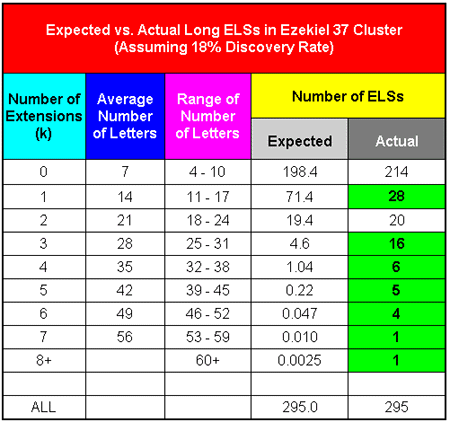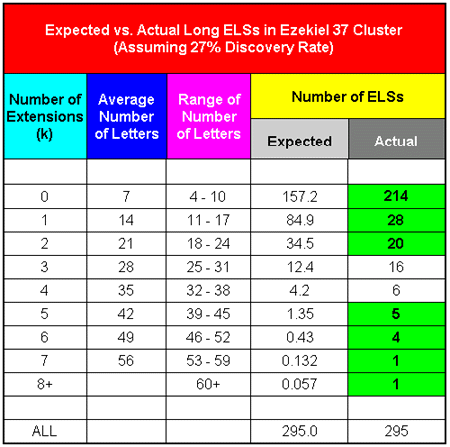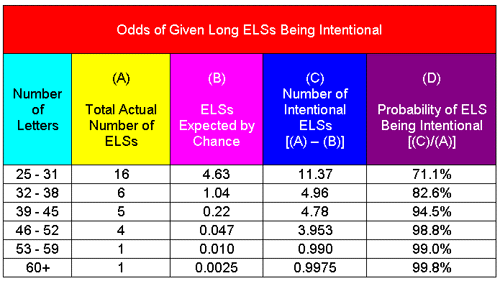| |
 A Firm Conclusion:
A Firm Conclusion:
The Ezekiel 37 Cluster Cannot Be A Coincidence
Is it possible for a cluster as extensive as Ezekiel 37 to be the result of chance? Given that the Islamic Nation Experiment has provided examples of longer ELSs from War and Peace, should code proponents fold up their tents and head off to other pursuits? Far from it, as we will see.
The plain fact is that the sheer number of lengthy ELSs in Ezekiel 37 far exceeds what chance could produce.
In this article we will describe how we used one of the key results of that Experiment—that in an ordinary text there is an 18% chance (per search opportunity) that a Hebrew expert would find an extension to an initial ELS—to specifically answer this question.
To date, we have only examined 295 initial ELSs located in Ezekiel 37. And yet, from that review 33 ELSs emerged that are 25+ letters-long. If we had been working with War and Peace, we would have expected to only find six (5.95 to be exact) ELSs 25+ letters-long. That is an enormous difference, and the improbability of Dr. Jacobi finding 33 such long ELSs by chance is essentially zero, by any reasonable probability estimation process. We estimate that the odds of chance occurrence of a cluster as extensive as Ezekiel 37 emerging from 295 initial ELSs are 1 out of 6 followed by 213 zeroes. In other words, Ezekiel 37 is an impossibility.
In the experiment described in the previous article, it was noted that Dr. Jacobi found an extension to an existing ELS from War & Peace 17.949% of the time. We will round this probability up to 18% and denote it by the letter a. The average extension he found was 6.95 letters long—which was rounded up to 7 letters.
In the technical addendum to this article a formula was derived for the expected number of ELSs with k extensions to emerge from an examination of an initial group of n ELSs found in a text. That formula is
|

To date we have examined 295 initial ELSs in Ezekiel 37 to determine whether or not a longer ELS could be found among the letters appearing on either side of the initial ELS at the same skip intervals. Each extended ELS must consist of grammatically correct Hebrew and be reasonably intelligible.
On the basis of the above formula and assumptions [i.e., n = 295, discovery rate = .18], the expected number of extended ELSs of various lengths is displayed in the following table, along side the actual number of extended ELSs that have been discovered to date in Ezekiel 37.
|

The actual number of extended ELSs of different lengths in Ezekiel 37 was reasonably close to expected for only two categories—those with zero and two extensions. For all other categories (shaded in green), there were statistically significant differences between actual and expected. If the frequency of extended ELSs in Ezekiel 37 had conformed to that from War & Peace, we would expect to find 5.95 ELSs consisting of three or more extensions (and having 25 or more total letters). That is a significant number of long ELSs—an indication of the fact that the terseness of Hebrew and the absence of vowels can result in the “discovery” of some longer ELSs—even in Tolstoy’s writings.
In actuality, Dr. Jacobi found 33 ELSs in Ezekiel 37 that consisted of 25 or more letters—approximately 454% more than the 5.95 expected by chance. This is an extremely significant difference statistically—no matter how one estimates the probability of its occurrence by chance. Stated simply, the above table demonstrates three very important findings:
- Longer ELSs can be “discovered,” even in ordinary texts, with some degree of frequency. This affirms the claim of code skeptics that "codes" can be found in any book.
- The actual number of longer ELSs in Ezekiel 37 far exceeds that explainable by chance, conclusively affirming the claim that some real Bible codes do exist. The odds of a cluster of long ELSs as extensive as that in Ezekiel 37 being the result of chance is 1 out of 6 followed by 213 zeroes. This is based on a chi square probability (calculated by EXCEL’s CHITEST function) applied to all extension categories. This probability does not change much if it is only applied to the longer extension categories—since it is the dramatic contrast between actual and expected findings in those categories that is the predominant source of improbability.
What is critical in answering the question of whether or not some Bible codes are intentional are differences in the discovery rate of extensions. As noted in the Islamic Nations Experiment article, the discovery rate was 18.0% in War & Peace and 27.0% in Ezekiel. The discovery rate for the first extension in Ezekiel was only 14.8%. However, once at least one extension had been found, there was a 49.7% chance that an additional extension would be found—each time there was an opportunity to search for one. A discovery rate of virtually 50% is unimaginable—unless numerous very lengthy ELSs were intentionally placed in Ezekiel 37.
It is not our expectation that such a high discovery rate would persist within any given section of the Bible and any topically related collection of initial ELSs. Lengthy ELSs tend to be topically related to the surface text as well as to one another. Consequently, we would not expect that a collection of initial ELSs about the Hawaiian Islands would result in a high discovery rate in Ezekiel 37. On the other hand, the topic of recent terrorist related events is very heavily represented by long ELSs in Ezekiel 37, as is demonstrated in the above table.
What if we used the 27.0% discovery rate for Ezekiel from the Islamic Nations Experiment in calculating the odds? First, we get the following comparison.
|

The odds of a cluster of long ELSs as extensive as that in Ezekiel 37 being the result of chance is 1 out of 114,300,000,000,000,000,000,000,000. As sensitive as the odds are to the assumed discovery rate, those odds are essentially zero for any realistic discovery rate.
Another key finding is that the odds of a given long ELS being intentional increase dramatically for longer ELSs. If one assumes that all long ELSs in excess of the number expected by chance are intentional, the odds of a given long ELS being intentional can be easily calculated, and are shown in the table below.
|

The above analysis is over-simplified, if only because it is possible for a long ELS to be partly intentional and partly coincidental. Nevertheless, the above table is indicative of the fact that increasing length does tip the odds in favor of a long ELS being intentional.
|
Enjoy finding your own Bible codes.
Bible code search software is available in our online store.
Subscribe Free! Sign Up Today!
Become a member of the non-profit Isaac Newton Bible Code Research Society.
Not only will you be part of the world's leading organization researching and publicizing Bible and Torah codes, but you will receive Bible Code Digest absolutely free, including . . .
- Latest Bible Code News
- Easy-to-Understand Bible Code Feature Articles
- Exciting Inside Information from Leading Code Researchers
- Details of Great New Discoveries
- Summaries of the Latest Battles Between Code Proponents and Skeptics
Stay current on Bible code news. Be first to hear about all of the latest Bible code discoveries.
Sign up to receive Bible Code Digest today.
|
|







Click here
and sign up to receive Bible Code Digest with no cost or obligation.
 Code Skeptics' Arguments Trashed Ever since the first Bible codes were announced, skeptics have been saying, "Oh, well, you can also find codes like that in books like War and Peace and Moby Dick."
We took the time to examine this notion and the best example of it that the skeptics have been able to come up with. The results of our research have completely blown away their theory.
Click here to see for yourself.
NEW: Second Study Undermines
Skeptics' Main Objection
to Codes
Click here for report |











